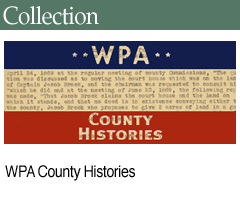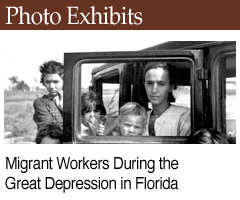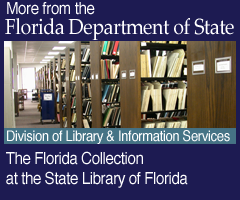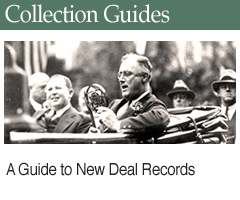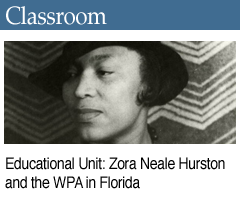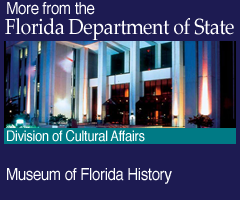WPA Church Records
Brief History of the Florida Church Archives Inventory
In 1933, Dr. Jean Stephenson, Chair of the Daughters of the American Revolution, proposed a massive project to help alleviate unemployment among white-collar Americans suffering through the Great Depression. She hoped to garner support for a nationwide archival project aimed at conducting a comprehensive survey of historical records at the county, state and national level. Dr. Stephenson’s proposal gained widespread support among New Dealers. The Works Progress Administration (WPA) allocated $15.5 million for the project, dubbed the Historical Records Survey (HRS). Dr. Luther H. Evans, professor of political science at Princeton University, was appointed head of the HRS. Work began immediately, and by April 1936, projects were underway in every state.[1]
The Historical Records Survey represented an unprecedented effort by the federal government to catalog archival holdings in various institutions retaining historical records. One of the most significant undertakings of the HRS was a nationwide survey of churches and church records, known as the Church Archives Inventory (CAI). Each state generated a list of known churches and synagogues to be surveyed, organized by county. Survey workers ventured into the field to document church histories and record holdings by interviewing clergy and congregation members. The form used by field workers for the CAI, Form 20HR, included fields for church name (or names), address, name of the pastor, architectural and building details, race and size of the congregation, location of church records, and additional information deemed relevant.[2]
In addition to the required elements in the survey form, field agents often elaborated on historical information gleaned through interviews. Notes by field workers for the Church Archives Inventory offer tremendous potential to researchers. The CAI contain valuable documents for historical and genealogical data, especially on the local level. According to historian William F. McDonald, “The records of churches and religious organizations are a major source of data on American social history, and frequently the only source from which vital statistics can be obtained for the period prior to compulsory official registration.”[3] The CAI provides unique insight into the history of the religious institutions at the center of community life.
The Florida Church Archives Inventory
The Florida branch of the Historical Records Survey-Church Archives Inventory began with the daunting task of surveying approximately 6,300 churches.[4] As in other states, the work was done by field workers assigned to each county. In larger counties, such as Duval, Dade and Hillsborough, CAI files are organized by denomination. The largest denominations in Florida in the early 20th century were Baptist and Methodist. Archival boxes for larger counties include separate folders for the Baptist and Methodist churches, with all other denominations gathered into one folder. Jewish congregations for all Florida counties are contained within their own box, number 21. Folders for smaller counties, such as Indian River, Levy and Liberty, contain all church surveys in a single file. In total, the CAI for Florida comprises 21 boxes and 5,439 individual church surveys.[5]
The surveys for the First Baptist and Bethel Baptist churches in Jacksonville serve as examples that illustrate the value of the Church Archives Inventory for researchers.[6] One of the oldest churches in the Jacksonville area, First Baptist, was founded in 1838 as Bethel Baptist Church. The six charter members included Reverend James McDonald, Elias Jaudon, their wives, and two African-American slaves, referred to in an interview accompanying the survey as Peggy and Bacchus. Thereafter, Bethel Baptist had a biracial congregation, relatively common for antebellum Baptist churches.[7] By the time of the Civil War in 1861, Bethel Baptist counted “forty white members and two hundred fifty colored members.” During the war, the church, at that time located on West Street, served as a military hospital. Following the battle of Olustee in February 1864, federal troops brought the wounded to the church for treatment.[8]
The Civil War left the church in a “deplorable condition,” according to Church Secretary Mrs. J. M. Aldridge, “the window panes broken out, the plaster off the walls, and filth and dirt everywhere.” The Civil War also divided the congregation. African-Americans formed the Bethel Baptist Church, while white members established Tabernacle Baptist Church.[9] The 1901 fire in downtown Jacksonville destroyed much of First Baptist Church (changed from Tabernacle Baptist in 1892). Church members quickly raised $16,000 to rebuild, completing construction on a new building in 1904. The church still occupied the rebuilt structure when survey field workers arrived in the late 1930s. Property owned by the church at the time of the CAI survey included a pipe organ valued at $35,000.[10]
The African-American Bethel Baptist Church of Jacksonville held equally impressive property. The field worker who completed the survey of Bethel Baptist noted that the church building was “[e]laborately constructed…of Renaissance and Mission type,” containing “70 art glass windows.” “The Deacons,” the survey explained, “receive their communion from individual silver glasses especially reserved for them.” The file for Bethel Baptist in Jacksonville also contains a church flier, depicting the building and pastor at the time, Reverend J. E. Ford.[11] Despite being torn apart by segregation and the racial tensions that characterized the Jim Crow south, both First Baptist and Bethel Baptist attained landmark status as historic churches in the Jacksonville community.
The surveys of the First Baptist and Bethel Baptist churches in Jacksonville are just two of thousands of similar documents included in the Church Archives Inventory files for Florida. Emerging from these seemingly mundane surveys, intended by the WPA to be collected in an “assembly line” fashion, are rich glimpses into the history of Florida communities and their places of worship.[12] By digitizing the Florida CAI, the State Library and Archives of Florida hopes to facilitate public access to these valuable historical resources and further the study of Florida history.
Notes
- ^ William F. McDonald, Federal Relief Administration and the Arts: The Origins and Administrative History of the Arts Projects of the Works Progress Administration (Columbus, OH: Ohio State University Press, 1969), 751-810.
- ^ Historical Records Survey, Division of Professional and Service Projects, Works Progress Administration, A Manual for Field Workers of the Church Archives Inventory in Florida (Jacksonville, FL: The Historical Records Survey, 1939). [Hereafter as HRS, Manual for…Church Archives Inventory in Florida]
- ^ McDonald, Federal Relief Administration and the Arts, 807.
- ^ HRS, Manual for…Church Archives Inventory in Florida, x.
- ^ The CAI’s are also available on 22 microfilm reels.
- ^ "First Baptist Church, Jacksonville, Florida," Box 4, Duval, Folder 1: Baptist, in Florida Historical Records Survey, Inventory of the Church Archives of Florida, Prepared by the Florida Historical Records Survey, Works Progress Administration, Professional and Service Division (Jacksonville, FL: Historical Records Survey, 1940). [Hereafter as CAI]
- ^ See John B. Boles, ed., Masters and Slaves in the House of the Lord: Race and Religion in the American South (Lexington: University of Kentucky Press, 1988) and C. Vann Woodward, The Strange Career of Jim Crow, 2nd rev. ed. (New York: Oxford University Press, 1966).
- ^ "First Baptist Church, Jacksonville, Florida," interview with Mrs. J. M. Aldridge, Church Secretary, Box 4, Duval, Folder 1: Baptist, CAI.
- ^ The African-American Bethel Baptist Church has its own record, Box 4, Duval County, Folder 1: Baptist, CAI.
- ^ "First Baptist Church, Jacksonville, Florida," interview with Mrs. J. M. Aldridge, Church Secretary, Box 4, Duval, Folder 1: Baptist, CAI.
- ^ "Bethel Baptist Institutional Church, Jacksonville, Florida," Box 4, Duval, Folder 1: Baptist, CAI.
- ^ McDonald, Federal Relief Administration and the Arts, 751.

 Listen: The Assorted Selections Program
Listen: The Assorted Selections Program